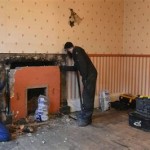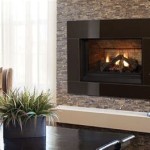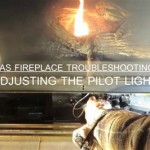Ventless Gel Fireplace Logs: A Comprehensive Guide
Ventless gel fireplace logs offer an alternative to traditional wood-burning fireplaces. They provide the ambiance of a fire without the need for a chimney, flue, or gas line. This article explores the composition, function, safety considerations, maintenance, and aesthetic value of ventless gel fireplace logs.
The primary appeal of ventless gel fireplaces and their associated logs lies in their ease of installation and use. Traditional fireplaces require extensive construction, including a chimney and gas line installation, which can be expensive and time-consuming. Ventless options eliminate these requirements, making them suitable for apartments, condos, or homes where installing a traditional fireplace is not feasible or desirable. Furthermore, they represent a cleaner-burning alternative to conventional wood fireplaces, producing less particulate matter and reducing the risk of creosote buildup.
The market offers a diverse range of ventless gel fireplace logs, varying in size, shape, and aesthetic design. Consumers can select logs that mimic the appearance of natural wood, including oak, birch, or pine. Some models also incorporate features that enhance the visual experience, such as glowing embers or realistic flame patterns. The selection process involves considering the size of the room, the desired heat output, and the overall design aesthetic.
Composition and Function of Gel Fireplace Logs
Ventless gel fireplace logs are not actually logs in the conventional sense. They are typically ceramic or concrete logs designed to contain and support the burning of gel fuel. The primary combustible component is the gel fuel, which is a mixture of isopropyl alcohol, water, and a thickening agent (usually a form of cellulose). The alcohol content accounts for the majority of the fuel's energy value, while the water serves to regulate the burning rate. The thickening agent gives the fuel its gel-like consistency, allowing it to be contained within a designated reservoir or can.
The combustion process begins when the gel fuel is ignited. The alcohol vaporizes and burns, producing heat and carbon dioxide. Unlike wood-burning fireplaces, ventless gel fireplaces do not produce smoke, soot, or ash. The absence of these byproducts is a significant advantage, contributing to a cleaner and more convenient user experience. The heat generated by the burning gel fuel warms the surrounding air, providing supplemental heating to the room. The amount of heat produced depends on the size of the fuel container and the duration of the burn.
The ceramic or concrete logs play a critical role in distributing the heat and creating a realistic flame appearance. They are designed to withstand high temperatures without cracking or degrading. The logs are often arranged around the fuel container to mimic the look of a traditional wood fire. Some models also incorporate features that enhance the visual effect, such as glowing embers made of ceramic wool or reflective materials that simulate the flickering of flames.
The burning time of gel fuel varies depending on the size of the container and the burning rate. A typical can of gel fuel can burn for approximately 2-3 hours. The heat output is usually measured in British Thermal Units (BTUs), and it typically ranges from 3,000 to 9,000 BTUs per hour. This level of heat is sufficient for supplemental heating in smaller rooms, but it may not be adequate for heating larger spaces.
Safety Considerations for Ventless Gel Fireplace Logs
While ventless gel fireplaces offer convenience and aesthetic appeal, safety precautions are paramount. The combustion process produces carbon dioxide, and in poorly ventilated rooms, the concentration of carbon dioxide can rise to dangerous levels. Therefore, it is crucial to ensure adequate ventilation when operating a ventless gel fireplace. Opening a window or door slightly can provide sufficient airflow to prevent carbon dioxide buildup. Installation of a carbon monoxide detector is also strongly recommended as a secondary precaution.
The gel fuel itself poses a potential fire hazard if not handled properly. It is highly flammable and should be stored in a cool, dry place away from direct sunlight and other sources of ignition. Avoid spilling gel fuel when refilling the container, and always clean up any spills immediately. Never add fuel to a burning fire or to a container that is still hot. Allow the container to cool completely before refilling. Proper disposal of empty gel fuel cans is also important. Follow local regulations for the disposal of flammable materials.
The surface of the fireplace and the ceramic logs can become very hot during operation. Exercise caution to avoid touching these surfaces, especially if you have children or pets. Keep flammable materials, such as curtains, furniture, and clothing, away from the fireplace. A safety screen can provide an additional layer of protection, preventing accidental contact with the hot surfaces. Regular inspection of the fireplace and logs is crucial to identify any signs of damage or wear. Replace any damaged components immediately to prevent potential hazards.
One often overlooked aspect of safety relates to the quality of the gel fuel itself. It's important to utilize only gel fuel specifically designed for ventless fireplaces. Using other flammable substances may result in incomplete combustion, producing harmful fumes or posing a fire risk. Furthermore, ensure the fuel is stored correctly to prevent degradation, which can alter its burning properties and increase the likelihood of dangerous situations.
Maintenance and Aesthetic Value of Ventless Gel Fireplace Logs
Maintaining ventless gel fireplace logs is relatively straightforward compared to wood-burning fireplaces. The absence of smoke, soot, and ash eliminates the need for chimney sweeping or ash removal. The primary maintenance task involves cleaning the ceramic logs occasionally to remove any dust or debris. Use a soft cloth or brush to gently wipe the logs. Avoid using harsh chemicals or abrasive cleaners, as they can damage the surface of the logs.
The fireplace itself may require occasional cleaning to remove any spills or stains. Use a mild detergent and water to clean the exterior surfaces. Ensure that the fireplace is completely dry before using it again. Regular inspection of the fireplace and logs is crucial to identify any signs of damage or wear. Replace any damaged components immediately to maintain the aesthetic appeal and ensure safe operation. The area surrounding the fireplace should also be kept clean and free of clutter to minimize the risk of fire.
The aesthetic value of ventless gel fireplace logs is a significant factor in their popularity. They offer a visually appealing alternative to traditional fireplaces, providing the ambiance of a fire without the associated mess and hassle. The ceramic logs are designed to mimic the appearance of natural wood, creating a realistic and inviting atmosphere. The flickering flames add warmth and visual interest to the room, making it a more comfortable and enjoyable space. Consumers can select logs that complement their existing decor, choosing from a variety of styles and finishes.
Beyond the logs themselves, the overall design of the fireplace can contribute to its aesthetic appeal. Many ventless gel fireplaces are designed to be freestanding units, allowing them to be placed in various locations throughout the room. Other models are designed to be built into existing walls or fireplace openings. The choice depends on the individual's preferences and the specific layout of the room. Consider the surrounding decor when selecting a ventless gel fireplace to ensure that it blends seamlessly with the existing style.
The flexibility of ventless gel fireplaces extends to their portability. Certain units are designed to be easily moved from one room to another, allowing users to enjoy the ambiance of a fire in different spaces. This portability makes them a versatile option for renters or homeowners who want to add a touch of warmth and visual interest to their living spaces without making permanent alterations.

Costway Ceramic Wood Gas Fireplace Log Set For Ventless Propane Inserts Vent Free Gel Ethanol Electric Indoor Outdoor Fireplaces And Fire Pits 10 Pcs Com

Regal Flame 5 Piece 16 Inch Ceramic Wood Gas Fireplace Logs For All Types Of Indoor Inserts Ventless Vent Free Propane Gel Ethanol Electric Or Outdoor Fireplaces Fire Pits

Costway Ceramic Wood Gas Fireplace Log Set For Ventless Propane Inserts Vent Free Gel Ethanol Electric Indoor Outdoor Fireplaces And Fire Pits 10 Pcs Com

Stanbroil 10 Piece Set Of Ceramic Wood Fireplace Logs For All Types Ventless Vent Free Gel Ethanol Electric Gas Inserts Propane Indoor Or Outdoor Fireplaces Fire Pits

Stanbroil Fireplace 4 Piece Set Of Ceramic Wood Logs For All Types Ventless Gel Ethanol Electric Gas Inserts Propane Indoor Or Outdoor Fireplaces Fire Pits Yahoo Ping

Regal Flame Rfa5005 16 In Ceramic Wood Gas Fireplace Logs Oak 5 Piece 1 Fry S Food

Ceramic Fiber Wood Small Size Gas Fireplace Logs For Most Types Of Ind Pasite

The Best Indoor Ventless Fireplaces For Your Home Or Apartment

Best Buy Real Flame Porter Indoor Ventless Gel Fireplace Walnut 7730

Stanbroil Fireplace 4 Piece Set Of Ceramic Wood Logs For All Types Ventless Gel Ethanol Electric Gas Inserts Propane Indoor Or Outdoor Fireplaces Fire Pits Yahoo Ping
Related Posts








